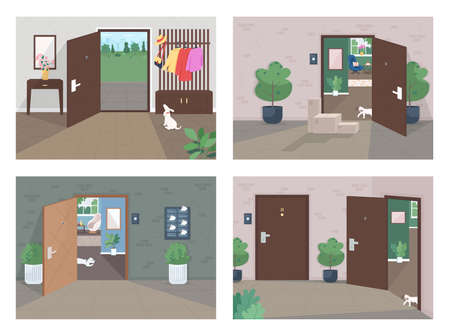Introduction to Natural Light in British Homes
Natural light holds a distinctive place in the everyday lives of people across the UK, weaving itself into the very fabric of British homes. From the honeyed glow that filters through the leaded windows of centuries-old cottages to the bright, open expanses of contemporary flats, sunlight is more than just a practical necessity—it shapes our routines, moods, and even our sense of home. The UKs unique climate, with its often overcast skies and shorter daylight hours during winter, makes any precious shaft of sunlight feel all the more treasured. In historic properties, natural light reveals intricate period details and brings warmth to thick stone walls, while in modern builds it is harnessed through expansive glazing and clever design to foster openness and wellbeing. Whether sipping morning tea in a sunlit bay window or arranging furniture to maximise every golden hour, Britons have developed an intrinsic appreciation for the transformative power of daylight within their living spaces.
2. The Science and Psychology of Light
Natural light is more than just a visual delight in British homes—it is a key factor influencing wellbeing, mood, and productivity. In the often overcast UK climate, the presence or absence of daylight can dramatically shape daily experiences within our living spaces. Scientific studies from institutions such as University College London highlight that exposure to natural light helps regulate our circadian rhythms, supporting healthier sleep patterns and stabilising mood throughout the day.
Wellbeing: The Role of Daylight in British Homes
For many British families, access to sunlight is associated with improved mental health. According to research by the Mental Health Foundation, rooms filled with daylight reduce symptoms of Seasonal Affective Disorder (SAD), a common concern during the long winter months. Homeowners in London and Manchester report feeling more energised and less anxious when their homes are designed to maximise natural light. This is particularly relevant for terraced houses and Victorian builds, where clever use of skylights and open-plan layouts make a tangible difference.
Mood and Productivity: Local Perspectives
| Aspect | Effect of Natural Light | UK Household Experience |
|---|---|---|
| Mood | Boosts serotonin levels, reduces stress | Residents note a brighter outlook during sunny periods; large windows in living rooms are highly valued |
| Productivity | Enhances focus, reduces fatigue | Home offices with south-facing windows are preferred for remote work in cities like Bristol and Edinburgh |
| General Wellbeing | Improves sleep quality, supports vitamin D synthesis | Families report better sleep routines and fewer colds when bedrooms receive morning sunlight |
Local Research Insights
A recent survey by the Royal Institute of British Architects (RIBA) found that 78% of UK homeowners would prioritise natural light if redesigning their homes. This reflects a growing awareness that well-lit interiors foster not only aesthetic pleasure but also tangible psychological benefits. In practice, north-facing properties often employ mirrors and lighter colour palettes to amplify available light, showcasing the ingenious ways Britons adapt their homes to the nation’s unique weather patterns.
The Everyday Impact on British Life
The transformative effect of natural light extends beyond scientific studies—it is woven into everyday domestic routines. From children completing homework by bay windows in Newcastle, to retirees enjoying tea in sunlit conservatories across Kent, these moments underline how crucial daylight is for comfort and happiness at home. Ultimately, embracing natural light has become an essential strategy for creating uplifting, productive spaces throughout the UK.

3. Before & After: Case Studies from Diverse UK Regions
Real transformation begins at home, and nothing illustrates this better than a closer look at how natural light has changed daily life in houses across the UK. From the bustling streets of London to the quiet charm of rural Cumbria, these examples show just how powerful sunlight can be when it’s thoughtfully integrated into living spaces.
Victorian Terraces in London
In South London, a family living in a classic Victorian terrace decided to reimagine their dark, narrow kitchen. By replacing a solid back door with glazed French doors and installing a skylight above the dining area, they opened up the room to streams of daylight. The result? A once-shadowy space now feels airy and welcoming, making it the heart of family gatherings and everyday meals.
Edwardian Semis in Manchester
Moving north, an Edwardian semi-detached house in Manchester underwent a loft conversion. Previously used for storage, the attic was transformed into a bright home office by adding large roof windows. This not only maximised underused space but also improved productivity and mood for its remote-working owner—proving that natural light is more than just an aesthetic upgrade.
Cottages in the Lake District
In the picturesque Lake District, traditional stone cottages often struggle with small windows and low ceilings. One couple tackled this by swapping out heavy drapes for minimalist blinds and painting walls in pale, reflective hues. Simple changes let more daylight flood in, turning what was once a gloomy sitting room into a serene retreat for reading or enjoying tea while watching the changing skies outside.
Key Takeaway: Every Home Can Benefit
Whether you’re nestled in an urban terrace or a country cottage, these real-life case studies highlight how even modest adjustments—new windows, lighter colours, clever layouts—can radically enhance your home’s atmosphere through natural light. The stories prove that no matter where you live in the UK, embracing daylight is a practical step towards both beauty and wellbeing.
4. Design Choices: Maximising Light with British Weather in Mind
Living in the UK often means contending with overcast skies, shorter winter days, and period properties that weren’t originally designed to maximise daylight. However, British homeowners are nothing if not resourceful when it comes to transforming their homes into brighter, more uplifting spaces. Here’s a look at some of the most creative and practical solutions used across the country, all while working within the unique constraints of British weather and architecture.
Window Strategies That Work
One of the first considerations is window placement and style. Bay windows are a classic feature in Victorian and Edwardian homes, offering panoramic light capture even on dull days. Modern renovations often see the installation of larger casement or picture windows, or the addition of rooflights and skylights—particularly popular in loft conversions or kitchen extensions.
| Design Feature | Benefit for Natural Light | Typical Usage |
|---|---|---|
| Bay Windows | Increase surface area for light entry; add charm | Front lounges, sitting rooms |
| Rooflights/Skylights | Direct overhead light; brightens deep-plan spaces | Kitchens, lofts, bathrooms |
| Glass Internal Doors | Allow light flow between rooms; maintain privacy | Hallways, home offices |
| Bifold/French Doors | Connects indoors with garden; maximises south-facing exposure | Kitchens, dining areas |
Clever Use of Colour and Materials
The UK’s muted daylight makes interior colour choices especially important. Pale shades—think off-whites, soft greys, or gentle pastels—are favoured for walls and ceilings to reflect as much light as possible. Gloss finishes on cabinetry or tiles can bounce natural light around a room, while strategically placed mirrors serve as secret weapons to double perceived brightness.
Seasonality: Adapting to the Changing Sunlight
With long summer evenings and brief winter afternoons, flexibility is key. Layered window treatments—combining voile curtains with heavier drapes—allow you to make the most of every ray without sacrificing warmth or privacy when needed. Some households install light shelves above windowsills: these simple ledges help redirect sunlight deeper into a room during low-sun months.
Overcoming Architectural Constraints
Period terraces and semis can present tough challenges: thick walls, small windows, or north-facing aspects. In these cases, opening up interiors by removing non-structural walls or creating open-plan living zones can flood formerly gloomy corners with shared daylight. For listed buildings where external changes are limited, swapping out solid doors for glazed alternatives is a subtle but effective trick.
5. Everyday Living: Stories from UK Residents
Across the United Kingdom, households are discovering how the simple act of inviting more natural light into their homes can make a world of difference to daily living. From cosy Victorian terraces in Manchester to modern flats in London, the voices of local families and individuals reveal a shared appreciation for brighter, airier spaces.
Family Mornings Transformed
The Johnson family in Bristol recount how installing larger windows in their kitchen turned mornings from rushed and dreary to uplifting and sociable. “We used to huddle under artificial lights, but now the sunlight pours in,” says Mrs Johnson. Breakfast has become a time when everyone gathers willingly, drawn together by the warmth and energy the morning light brings.
A Flatmate’s Sanctuary
For Aisha, a university student sharing a flat in Edinburgh, prioritising natural light made her small bedroom feel less cramped and more like a sanctuary. “Opening up my curtains first thing is almost meditative. It sets a positive tone for revision and rest,” she shares, noting that she now spends more time studying at her desk instead of seeking out coffee shops for inspiration.
Energy and Wellbeing Boosts
Many residents report noticeable improvements in their mood and energy levels. Mr Clark, who works remotely from his converted loft in Leeds, swapped heavy blinds for sheer panels. He explains, “My productivity has soared since making this change. The space feels bigger and I no longer struggle with afternoon slumps.”
Gathering Spaces Reimagined
In suburban Surrey, the Patel family redesigned their living room around a new skylight. Now it’s the heart of the home: “We spend more time together here—reading, chatting, or just enjoying the ever-changing sky,” Mrs Patel remarks. Guests often comment on the fresh atmosphere that makes even rainy days feel inviting.
Embracing Natural Light as a Lifestyle
The consensus among these UK residents is clear: incorporating natural light isn’t just about aesthetics—it’s about nurturing wellbeing, fostering connection, and transforming daily routines. Whether through thoughtful renovations or simple tweaks like changing window dressings, embracing daylight has brought out the best in their homes and lives.
6. Practical Tips for Bringing More Light into Your UK Home
Rethink Your Room Layout
Start by evaluating how your furniture is arranged. In many UK homes, heavy sofas or wardrobes can unintentionally block natural light from windows. Try moving larger pieces away from window areas and opt for low-profile furnishings near sources of daylight. Consider open shelving instead of bulky cabinets, especially in living rooms and kitchens, to allow light to travel freely throughout the space.
Choose Light-Enhancing Paint Colours
The British climate often brings grey skies, so it’s worth selecting paint colours that maximise brightness indoors. Soft whites, gentle creams, and muted pastels reflect more daylight than deep shades. For period properties with original features, off-white with a hint of warmth can complement cornices or dado rails while still bouncing light around the room.
Use Mirrors Strategically
Mirrors are a classic trick in UK interiors for amplifying natural light. Place a large mirror opposite or adjacent to a window to double the daylight effect. For narrow hallways—a common feature in Victorian terraces—long mirrors can create an airy illusion and draw sunlight further inside.
Opt for Sheer or Layered Window Treatments
Heavy curtains are traditional, but they often trap precious daylight. Swap out thick drapes for lightweight voiles or linen sheers that provide privacy without sacrificing sunbeams. For chilly winter months, combine sheers with thermal blinds or interlined curtains you can pull back during the day and close at dusk.
Keep Windows Spotless
It may sound simple, but clean windows make a remarkable difference, especially with Britain’s frequent rain showers leaving marks behind. A regular wipe-down removes grime and lets the maximum amount of light pour through—even on overcast days.
Add Glass Doors and Internal Glazing
If your budget allows, consider swapping solid doors for glazed ones between rooms. This is particularly effective in semis and terraces where hallways tend to be dark. Internal windows or borrowed-light panels above doors are another way to share sunlight between spaces while retaining period charm.
Embrace Light-Reflective Accessories
Finally, bring in reflective accessories such as metallic lamp bases, glass vases, or even glossy picture frames. These small touches capture stray rays and give everyday life in your UK home a brighter, more uplifting feel—all without major renovations.
7. Conclusion: The Lasting Impact of Light-Filled Homes
Reflecting on the transformative stories from UK homes, it is clear that natural light is far more than a design trend; it’s a cornerstone of British living and wellbeing. From Victorian terraces in London to modern flats in Manchester, daylight has proven to elevate not only the look and feel of spaces but also the quality of daily life. In a country where grey skies are familiar and space can be at a premium, harnessing sunlight becomes both a practical solution and a cultural aspiration. The subtle play of natural light through sash windows or skylights doesn’t just brighten interiors—it shapes moods, routines, and even social connections within our homes. Embracing daylight invites warmth into the heart of British households, fostering environments that nurture creativity, relaxation, and connection. As these case studies have shown, investing in brighter, airier living spaces offers enduring value—supporting healthier lifestyles, enhancing property appeal, and reflecting a uniquely British appreciation for home comfort and personal sanctuary. Ultimately, the journey toward light-filled homes is about more than aesthetics; it’s about creating places where memories are made and well-being thrives amidst the ever-changing UK weather.


